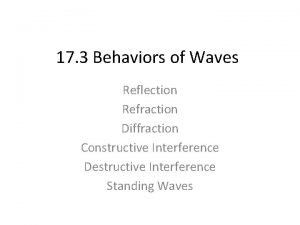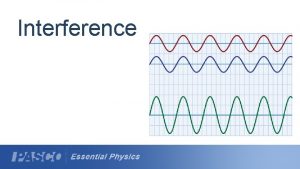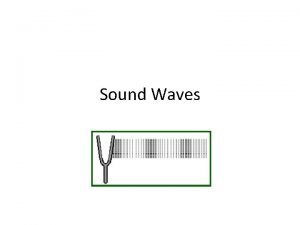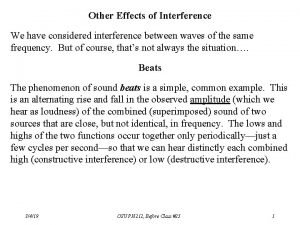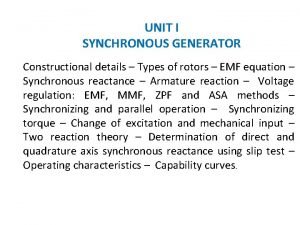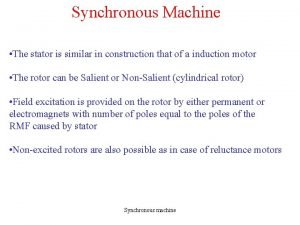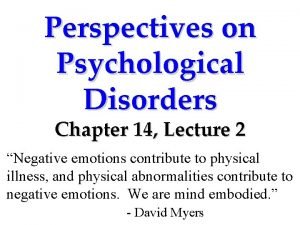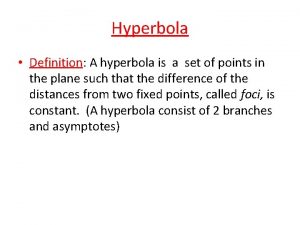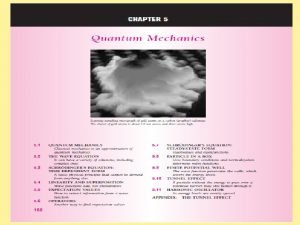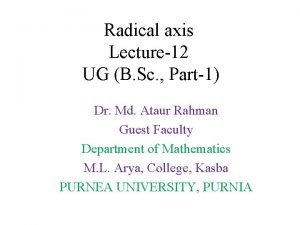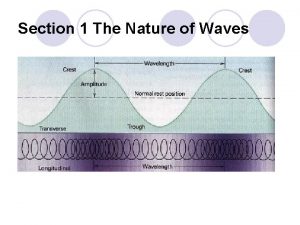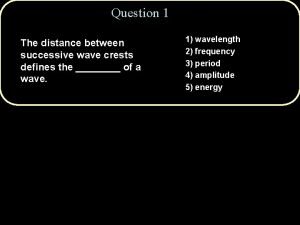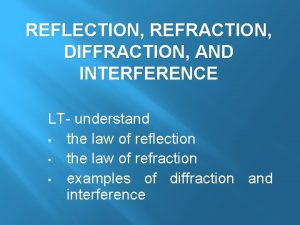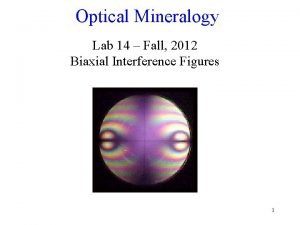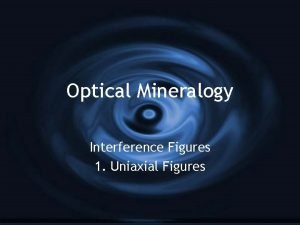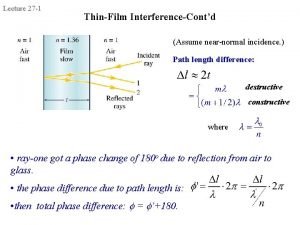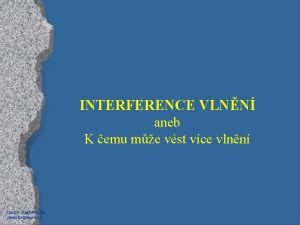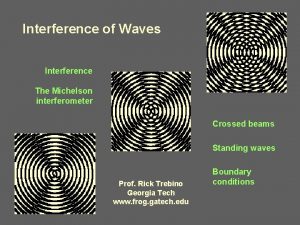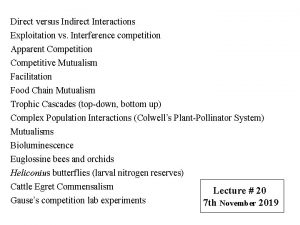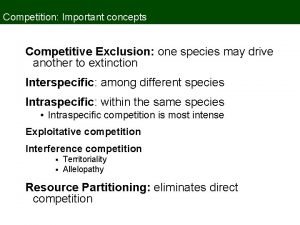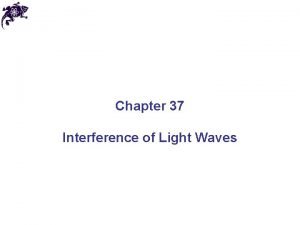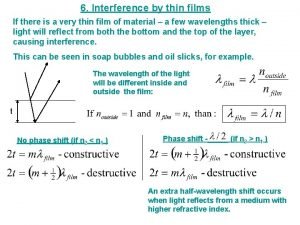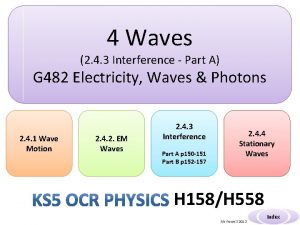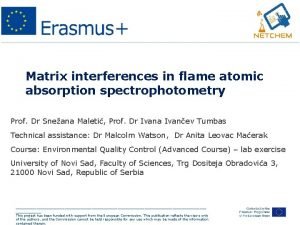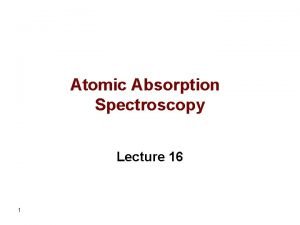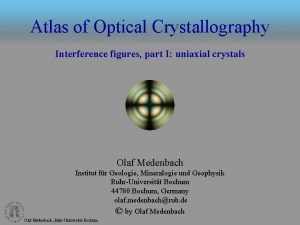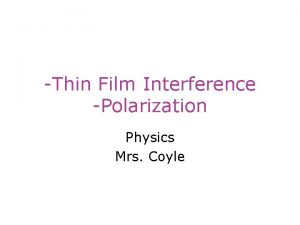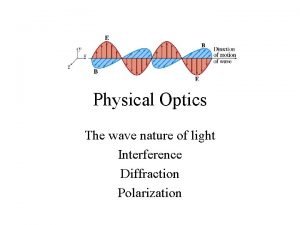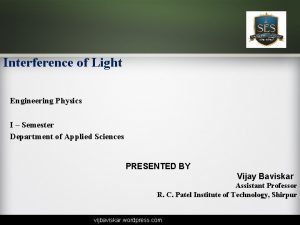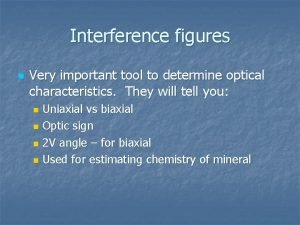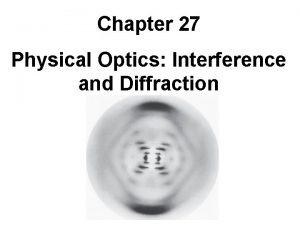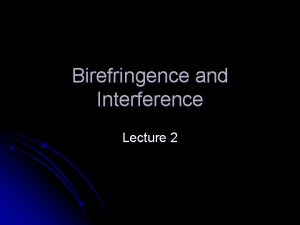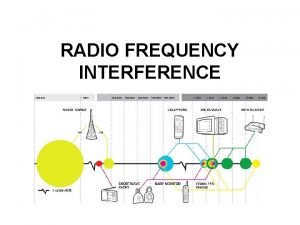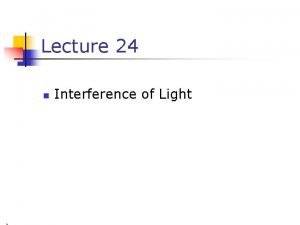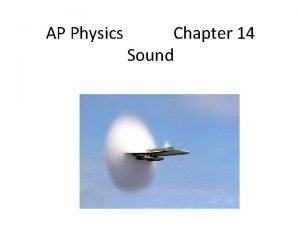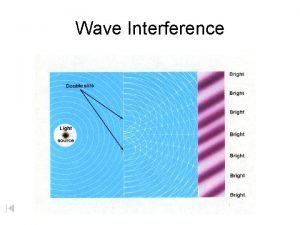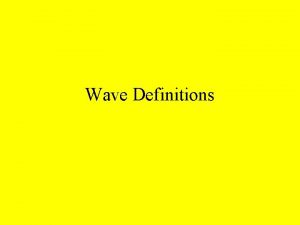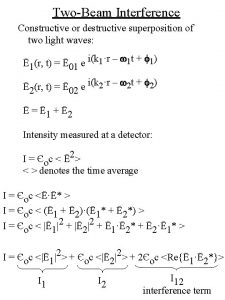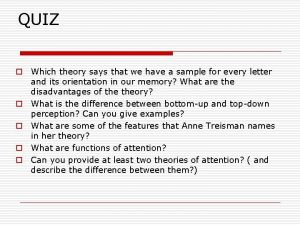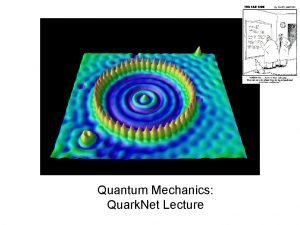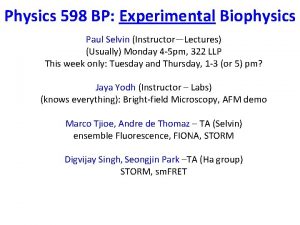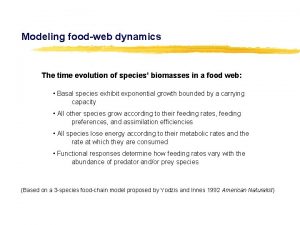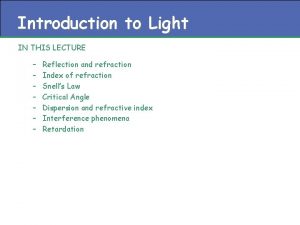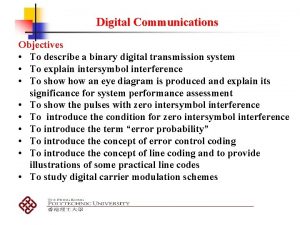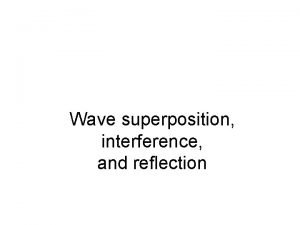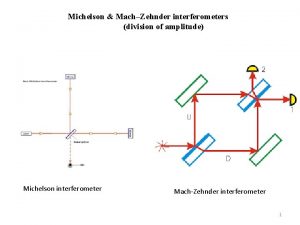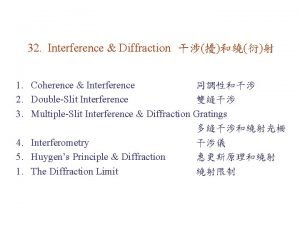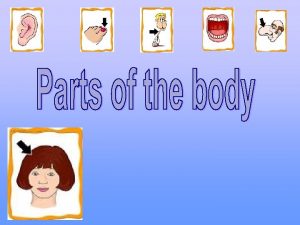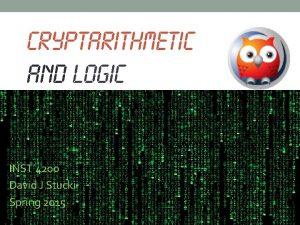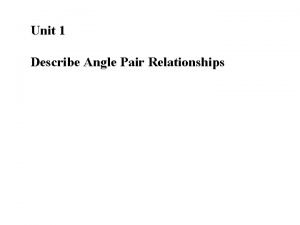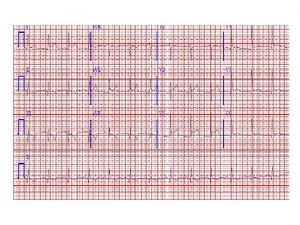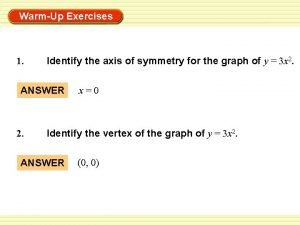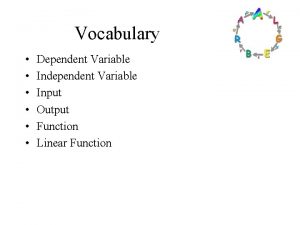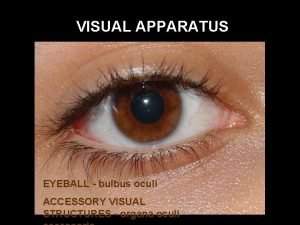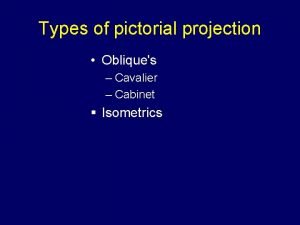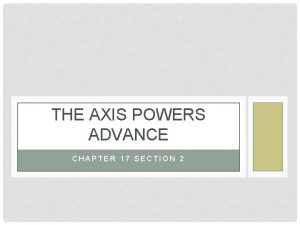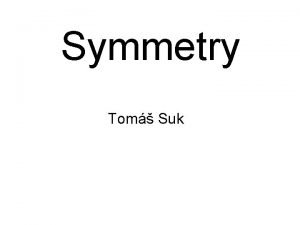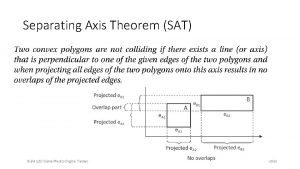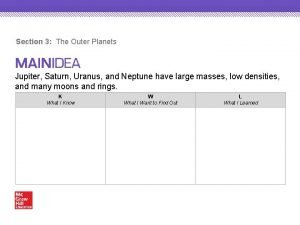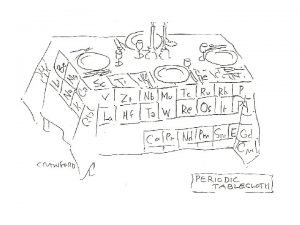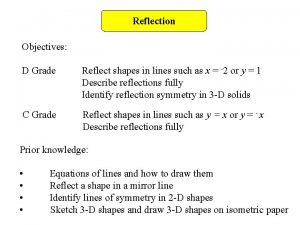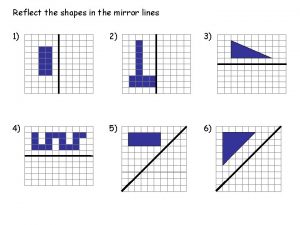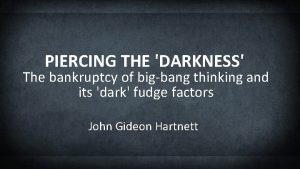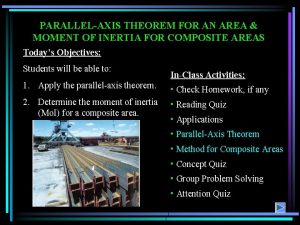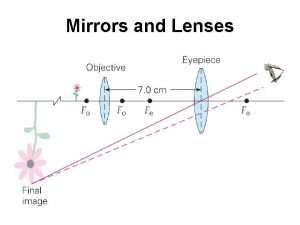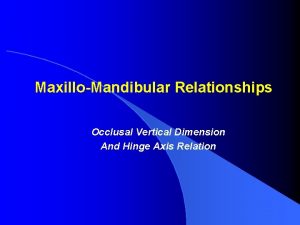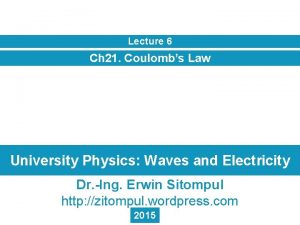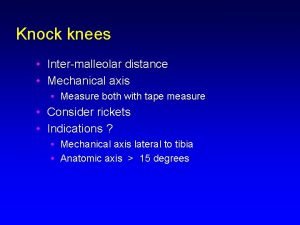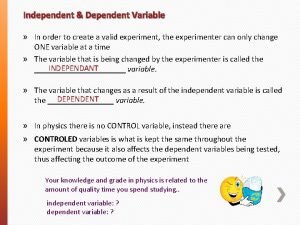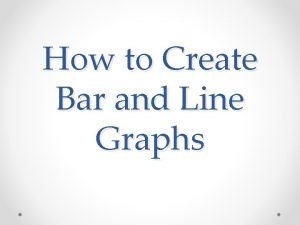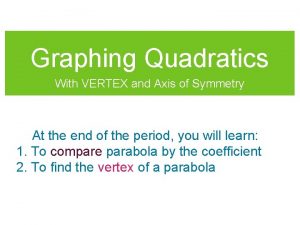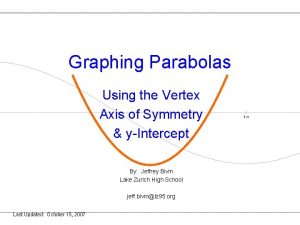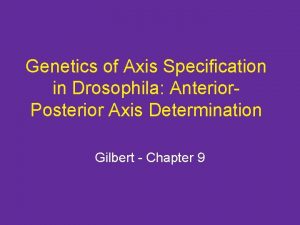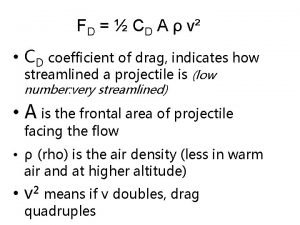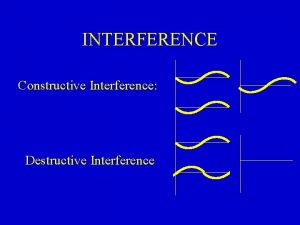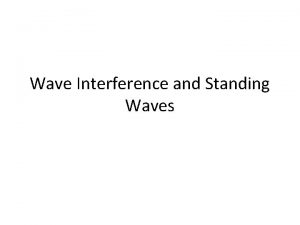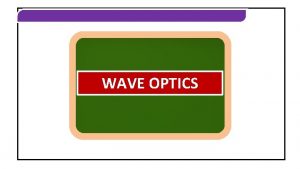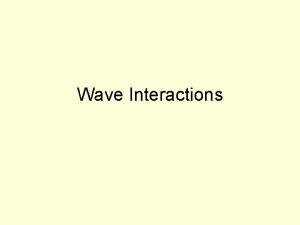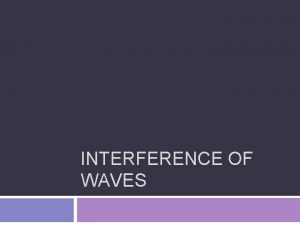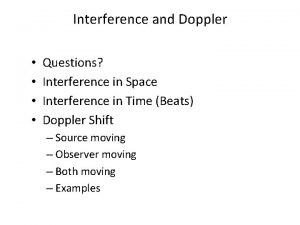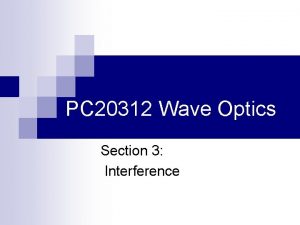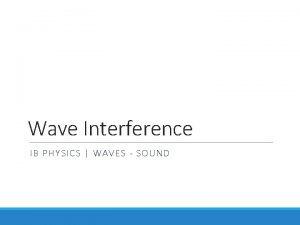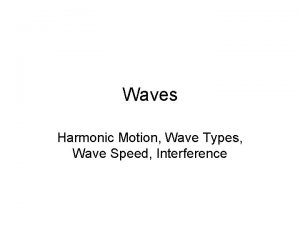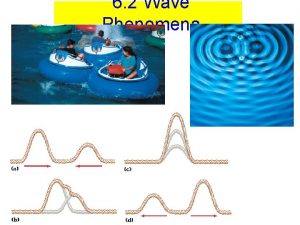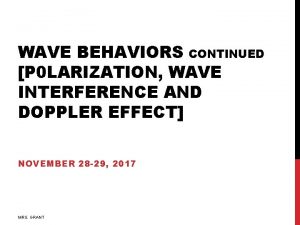Wave Interference y axis x axis When two




















































































































































































- Slides: 180

Wave Interference y axis x axis When two waves occur in sync with each other, constructive interference occurs causing the amplitude to increase. 8 -1

Wave Interference y axis x axis When two waves occur out of sync with each other, destructive interference occurs causing the amplitude to decrease. 8 -2

Electromagnetic radiation, EMR Defined as a form of energy that consists of perpendicular electrical and magnetic fields that change, at the same time and in phase, with time. The SI unit of frequency is the hertz, Hz 1 Hz = 1 s-1 Wavelength and frequency are related νλ=c c is the speed of light, 2. 998 x 108 m/s 8 -3

Electromagnetic radiation (EMR) and matter Transmission - EMR will pass through matter -- no interaction. Absorption - EMR is absorbed by an atom, ion or molecule, taking it to a higher energy state. Emission - the release of energy by an atom, ion or molecule as light, taking it to a lower energy state. 8 -4

Photoelectric Effect Einstein successfully explained the photoelectric effect Light is composed of packets of energy quantum called photons. Each photon carries a specific energy related to its wavelength photons of short wavelength (blue light) carry more energy than long wavelength (red light) photons. The energy of the photon determines if electricity flows Not the amount of light 8 -5

Photoelectric effect Studies of this effect led to the discovery that light existed as small particles of electromagnetic radiation called photons The energy of a photon is directly proportional to the frequency. Photon energy, E = h ν h - Planck’s constant, 6. 626 x 10 -34 J. S / photon Therefore, the energy must be inversely proportional to the wavelength. Photon energy = h c λ 8 -6

Photon energy example Determine the energy, in k. J/mol of a photon of blue-green light with a wavelength of 486 nm. energy of a photon = h c λ = (6. 626 x 10 -34 J. s)(2. 998 x 108 m. s-1) (4. 86 x 10 -7 m) = 4. 09 x 10 -19 J / photon 8 -7

Photon energy example We now need to determine the energy for a mole of photons (6. 02 x 1023) Energy for a mole of photons. = (4. 09 x 10 -19 J / photon) (6. 02 x 1023 photons/mol) = 246 000 J/mol Finally, convert to k. J = ( 244 000 J/mol ) 1 k. J 103 J = 244 k. J / mol 8 -8

Energy Changes in Atoms ‘White’ light is actually a blend of all visible wavelengths. They can separated using a prism.

Bohr model of the atom Bohr proposed a model of how electrons moved around the nucleus. • He wanted to explain why electrons did not fall in to the nucleus. • He also wanted to account for spectral lines being observed. He proposed that the energy of the electron was quantized - only occurred as specific energy levels. 8 - 10

Bohr model of the atom The Bohr model is a ‘planetary’ type model. The nucleus is at the center of the model. Electrons can only exist at specific energy levels (orbit). Each energy level was assigned a principal quantum number, n. Each principal quantum represents a new ‘orbit’ or layer. 8 - 11

Bohr Model E = -2. 178 x 10 -18 x Z 2 n 2 Z = nuclear charge N = energy level of the electron -2. 178 x 10 -18 = proportionality constant 8 - 12

Bohr model of the atom Bohr derived an equation that determined the energy of each allowed orbit for the electron in the hydrogen atom. n is the principle quantum number When electrons gain energy, they jump to a higher energy level which is farther from the nucleus. Energy is released when the electrons drops down to a lower energy level closer to the nucleus. 8 - 13

Bohr model of the atom n=4 -82 k. J n=5 -52 k. J n=3 -146 k. J n=2 -328 k. J n=1 -1312 k. J 8 - 14

Bohr model of the atom Bohr was able to use his model hydrogen to: • Account for the observed spectral lines. • Calculate the radius for hydrogen atoms. His model did not account for: • Atoms other than hydrogen. Why not? • Degenerate state? Ask me after we do quantum model! • Shielding? • Why energy was quantized. His concept of electrons moving in fixed orbits was later abandoned. 8 - 15

Wave theory of the electron 1924 De Broglie suggested that electrons have wave properties to account for why their energy was quantized. • He reasoned that the electron in the hydrogen atom was fixed in the space around the nucleus. • He felt that the electron would best be represented as a standing wave. • As a standing wave, each electron’s path must equal a whole number times the wavelength. 8 - 16

De Broglie waves Using de Broglie’s equation, we can calculate the wavelength of an electron. λ 6. 6 x 10 -34 kg m 2 s-1 = (9. 1 x 10 -31 kg)(2. 2 x 106 m s-1) = 3. 3 x 10 -10 m The speed of an electron had already been reported by Bohr as 2. 2 x 106 m s-1. 8 - 17

Heisenberg uncertainty principle • In order to observe an electron, one would need to hit it with photons having a very short wavelength and high frequency. • If one were to hit an electron, it would cause the motion and the speed of the electron to change. • Lower energy photons would have a smaller effect but would not give precise information. 8 - 18

Heisenberg uncertainty principle According to Heisenberg, it is impossible to know both the position and the speed of an object precisely. He developed the following relationship: h ∆x ∆(mv) > 4πm As the mass of an object gets smaller, the product of the uncertainty of its position (∆x) and speed (∆v) increase. 8 - 19

Quantum model of the atom Schrödinger developed an equation to describe the behavior and energies of electrons in atoms. • His equation is used to plot the position of the electron relative to the nucleus as a function of time. • While the equation is too complicated to write here, we can still use the results. • Each electron can be described in terms of its quantum numbers. 8 - 20

Quantum numbers Principal quantum number, n Tells the size of an orbital and largely determines its energy. n = 1, 2, 3, …… Orbital (azimuthal or angular momentum) quantum number, l The number of subshells that a principal level contains. It tells the shape of the orbitals. l = 0 to n - 1 8 - 21

Magnetic Quantum Number (ml) The magnetic quantum number describes the three-dimensional orientation of the orbital. Allowed values of ml are integers ranging from –l to +l: Therefore, on any given energy level, there can be up to 1 s orbital, 3 p orbitals, 5 d orbitals, 7 f orbitals, etc. 8 - 22

Magnetic Quantum Number (ml) Orbitals with the same value of n form a shell. Different orbital types within a shell are subshells. 8 - 23

s Orbitals The value of l for s orbitals is 0. They are spherical in shape. The radius of the sphere increases with the value of n. 8 - 24

s Orbitals Observing a graph of probabilities of finding an electron versus distance from the nucleus, we see that s orbitals possess n-1 nodes, or regions where there is 0 probability of finding an electron. 8 - 25

p Orbitals The value of l for p orbitals is 1. They have two lobes with a node between them. 8 - 26

d Orbitals The value of l for a d orbital is 2. Four of the five d orbitals have 4 lobes; the other resembles a p orbital with a doughnut around the center. 8 - 27

Energies of Orbitals For a one-electron hydrogen atom, orbitals on the same energy level have the same energy. That is, they are degenerate. 8 - 28

Energies of Orbitals As the number of electrons increases, though, so does the repulsion between them. Therefore, in manyelectron atoms, orbitals on the same energy level are no longer degenerate. 8 - 29

Spin Quantum Number, ms In the 1920 s, it was discovered that two electrons in the same orbital do not have exactly the same energy. The “spin” of an electron describes its magnetic field, which affects its energy. 8 - 30

Spin Quantum Number, ms This led to a fourth quantum number, the spin quantum number, ms. The spin quantum number only has 2 allowed values: +1/2 and -1/2. 8 - 31

Pauli Exclusion Principle No two electrons in the same atom can have exactly the same energy. Therefore, no two electrons in the same atom can have identical sets of quantum numbers. 8 - 32

Combined orbitals - n = 1, 2 & 3 1 s, 2 p, 3 s, 3 p and 3 d sublevels 8 - 33

Representative f orbitals There are seven f orbitals (4 have the eight-lobe shape) http: //www. uky. edu/~holler/html/orbitals_2. html 8 - 34

Quantum numbers Magnetic quantum number, m� Describes the orientation that the orbital has in space, relative to an x, y, z plot. m�= - �to + �(all integers, including zero) For example, if �= 1, then m�would have values of -1, 0, and +1. Knowing all three numbers provide us with a picture of all of the orbitals. 8 - 35

Electron configuration Things get a bit more complex where more than one electron is involved. Effective nuclear charge(kernel charge) Inner electrons act to shield outer ones from the positive charge of the nucleus. Some orbitals penetrate to the nucleus more than others: s > p > d > f 8 - 36

Aufbau(building) approach We can use this approach to ‘build’ atoms and describe their electron configurations. For any element, you know the number of electrons in the neutral atom equals the atomic number. For an ion, the number of electrons equals the number of protons minus the charge. Start filling orbitals, from lowest to highest energy. If two or more orbitals exist at the same energy sublevel, do not pair the electrons until you first have one electron per orbital. 8 - 37

Electron Configurations This shows the distribution of all electrons in an atom. Each component consists of A number denoting the energy level; 8 - 38

Electron Configurations This shows the distribution of all electrons in an atom. Each component consists of A number denoting the energy level, A letter denoting the type of orbital, 8 - 39

Electron Configurations This shows the distribution of all electrons in an atom. Each component consists of A number denoting the energy level, A letter denoting the type of orbital, A superscript denoting the number of electrons in those orbitals. 8 - 40

Major trends in electron filling 1 s 2 2 p 6 3 s 2 3 p 6 3 d 10 4 s 2 4 p 6 4 d 10 4 f 14 5 s 2 5 p 6 5 d 10 5 f 14 5 g 18 6 s 2 6 p 6 6 d 10 6 f 14 6 g 18 6 h 22 7 s 2 7 p 6 7 d 10 7 f 14 7 g 18 7 h 22 Blue sublevels not occupied… Not enough e- 7 i 26 8 - 41

Writing electron configurations Examples O Ti Br 1 s 2 2 p 4 1 s 2 2 p 6 3 s 2 3 p 6 4 s 2 3 d 2 1 s 2 2 p 6 3 s 2 3 p 6 4 s 2 3 d 10 4 p 5 Core format O Ti Br [He] 2 s 2 2 p 4 [Ar] 4 s 2 3 d 2 [Ar] 4 s 2 3 d 10 4 p 5 8 - 42

Classification by sublevels s p H d Li Be Na Mg K Ca Sc Ti Rb Sr Y V He B C N O F Al Si P S Cl Ar Cr Mn Fe Co Ni Cu Zn Ga Ge As Se Br Kr Zr Nb Mo Tc Ru Rh Pd Ag Cd In Sn Sb Te Cs Ba Lu Hf Ta W Re Os Ir Fr Ra Lr Ne I Xe Pt Au Hg Tl Pb Bi Po At Rn La Ce Pr Nd Pm Sm Eu Gd Tb Dy Ho Er Tm Yb f Ac Th Pa U Np Pu Am Cm Bk Cf Es Fm Md No 8 - 43

Aufbau examples energy 2 p 2 p 2 p 2 s 2 s 2 s 1 s 1 s 1 s C O F 8 - 44

Writing electron configurations Electron configurations can be written for atoms or ions. • Start with the ground-state configuration for the atom. • For positively-charged cations, remove a number of the outermost electrons equal to the charge. • For negatively-charged anions, add a number of outermost electrons equal to the charge. 8 - 45

Writing electron configurations Example - Cl. First, write the electron configuration for chlorine: Cl 17 e 1 s 2 2 p 6 3 s 2 3 p 5 or [Ne] 3 s 2 3 p 5 Because the charge is 1 -, add one electron. Cl- 1 s 2 2 p 6 3 s 2 3 p 6 or [Ne] 3 s 2 3 p 6 or [Ar] 8 - 46

Writing electron configurations Example - Ba 2+ First, write the electron configuration for barium. Ba 56 e- 1 s 2 2 p 6 3 s 2 3 p 6 4 s 2 3 d 10 4 p 6 5 s 2 4 d 10 5 p 6 6 s 2 or [Xe] 6 s 2 Because the charge is 2+, remove two electrons. Ba 2+ 1 s 2 2 p 6 3 s 2 3 p 6 4 s 2 3 d 10 4 p 6 5 s 2 4 d 10 5 p 6 or [Xe] or [Kr] 5 s 2 4 d 10 5 p 6 8 - 47

Hund’s Rule When putting electrons into orbitals with the same energy, place one electron in each orbital before pairing them up. The lone electrons will have the same direction of spin. The existence of unpaired electrons can be tested for since each acts like a tiny electromagnet. 8 - 48

Hund’s Rule Magnetism results from unpaired electrons in the ground state. Paramagnetic - attracted to magnetic field. Indicates the presence of unpaired electrons. Temporary! Diamagnetic - unaffected by a magnetic field. Indicates that all electrons are paired. Ferromagnet - When there are multiple unpaired electrons (like in iron), this results in a permanent magnet 8 - 49

Orbital Notation • A simple method used to show only the electrons in the highest main energy level. The d and f sublevels are not shown unless they are partially filled. • Indicates which orbitals are occupied and whether or not electrons are paired with other electrons in the orbitals. 8 - 50

Orbital Notation • For O, 1 s 2 2 p 4 , the orbital notation is 2 s 2 p O • Notice that the electrons do not pair up in orbitals of the same energy sublevel until each of the orbitals is occupied by a single electron, all spinning the same direction. (Hund’s Rule) 8 - 51

Orbital Notation • For V, 1 s 2 2 p 6 3 s 2 3 p 6 4 s 2 3 d 3 , the orbital notation is 4 s 3 d V • Notice that there must be five d orbitals shown, even though two of the orbitals are empty. 8 - 52

Irregularities in electron configurations There are several elements that have actual electron configurations that are different from those predicted. The predicted electron configuration for Cu is 1 s 2 2 p 6 3 s 2 3 p 6 4 s 2 3 d 9 , however the actual configuration is 1 s 2 2 p 6 3 s 2 3 p 6 4 s 1 3 d 10 4 s 3 d Cu The filled 3 d sublevel has less energy than the filled 4 s sublevel. 8 - 53

Irregularities in electron configurations Other elements follow a similar pattern, such as silver and gold. Ag 47 e- [Kr] 5 s 1 4 d 10 Au 79 e- [Xe] 6 s 1 4 f 14 5 d 10 The predicted electron configuration for Cr is 1 s 2 2 p 6 3 s 2 3 p 6 4 s 2 3 d 4 , however the actual configuration is 1 s 2 2 p 6 3 s 2 3 p 6 4 s 1 3 d 5 4 s 3 d Cr 8 - 54

Atomic Structure & Periodic Properties What factors of atomic structure effect the properties of the elements? 8 - 55

Atomic Structure & Periodic Properties Factor 1: Number of valence (outershell) electrons • The valence electrons are those in the highest numbered energy level that are used for chemical reactions. • An element will try to gain, lose or share electrons to get a structure similar to the inert gases. 8 - 56

Atomic Structure & Periodic Properties Factor 2: Number of main energy levels (shells) • The more shells of electrons an atom has, the farther the valence electrons are from the nucleus. • With each additional shell, the valence electrons are more shielded from the attraction of the nucleus and are held less tightly. 8 - 57

Atomic Structure & Periodic Properties Factor 3: The net nuclear force (a. kernel charge) • The net nuclear force is equal to the difference between the protons and the inner shell electrons. • It is a measure of the relative pulling power of the nucleus for the valence electrons. • For atoms, the kernel charge equals the Group A number. 8 - 58

Effective Nuclear Charge In a many-electron atom, electrons are both attracted to the nucleus and repelled by other electrons. The nuclear charge that an electron experiences depends on both factors. 8 - 59

Effective Nuclear Charge The effective nuclear charge, Zeff, is found this way: Zeff = Z – S Where Z is the atomic number and S is a screening constant, usually close to the number of inner electrons. (Assume this, don’t count valence electrons) 8 - 60

Alkali Metals Li 1 s 22 s 1 valence ekernel charge = 3 p-2 inner e- = +1 Na 1 s 22 p 63 s 1 valence e. KC =11 p-10 inner e- = +1 K 1 s 22 p 63 s 23 p 64 s 1 KC =19 p-18 inner e- = +1 valence e 8 - 61

Periodic trends Many trends in physical and chemical properties can be explained by electron configuration and atomic structure. We’ll look at some of the more important examples. Metal vs. Nonmetal reactivity Atomic radii vs. Ionic radii Ionization energies Electron affinities Electronegativity 8 - 62

What Is the Size of an Atom? The bonding atomic radius is defined as one-half of the distance between bonded nuclei. This is how we measure atomic radius. 8 - 63

Sizes of Atoms Atomic radius tends to… …decrease from left to right across a row due to increasing Zeff …increase from top to bottom of a column due to increasing value of n 8 - 64

Radus (pm) Atomic radii Atomic number (noble gases are not included) 8 - 65

Isoelectronic configurations Species that have the same electron configurations. Example Each of the following has an econfiguration of 1 s 2 2 p 6 O 2 - F- Ne Na+ Mg 2+ Al 3+ 8 - 66

Atomic radii of the main group elements Atoms get larger as you go down a group (vertical column). A new shell is being added, but the kernel charge remains the same. Atoms get smaller as you go across a period (horizontal row). The nucleus contains more protons with the same number of inner shell electrons. Which results in a higher kernel charge that attracts the same number of electron shells more strongly, making the atom smaller. 8 - 67

Ionic radii (pm = 10 -12 m) Li 152 Li+ 74 Be 111 Be 2+ 35 N 70 Na 186 Na+ 102 Mg 160 Mg 2+ P 72 110 K 227 K+ 138 Ca 197 Ca 2+ As 100 121 Rb 248 Rb+ 149 Sr 215 Sr 2+ 116 Cs 265 Cs+ 170 Ba 217 Ba 2+ 136 N 3171 O 66 O 2140 F 64 F 136 P 3212 S 104 S 2184 Cl 99 Cl 181 As 3222 Se 117 Se 2198 Br 114 Br 195 Te 137 Te 2221 I 133 I 216 atoms shown in blue 8 - 68

Ionization energy(IE) First ionization energy The energy to remove one electron from a neutral atom in the gas phase. A(g) + first ionization energy A+(g) + e- The higher the ionization energy, the stronger the attraction between the net nuclear force and the valence shell. This indicates how easy it is to form a cation. Metals tend to have lower first ionization energies than nonmetals. 8 - 69

First ionization energy In general, ionization energy increases when going towards the upper right side of the periodic table, but there are exceptions. H Li Be B C N O F Na Mg Al Si P S Cl K Ca Ga Ge As Se Br Rb Sr In Sn Sb Te I Cs Ba Tl Pb Bi Po At 8 - 70

First ionization energy (k. J/mol) He 1 s 2 Notice how the ionization energies are greater for those elements with filled s, p and d sublevels and half-filled p and d sublevels. Ne 2 p 6 Ar 3 p 6 Kr 4 p 6 2 p 3 3 p 3 2 s 2 3 s 2 Xe 5 p 6 4 p 3 3 d 10 5 d 10 4 f 14 Rn 6 p 6 6 p 3 Atomic number 8 - 71

Ionization energy Stability of filled and half-filled sublevels When all of the orbitals of a sublevel are filled (or when p, d and f sublevels are half-filled), the electron charge distribution is more stable. Therefore, more energy is required to remove an electron and the ionization energy is greater than expected, based upon the kernel charge and number of shells. 8 - 72

Ionization energy Successive ionization energies It is possible to remove more than one electron from an atom, but ionization energy increases with each successive electron removed. The amount of energy needed depends upon the kernel charge and electron structure of the positive ions that form. 8 - 73

Successive Ionization energy (k. J/mole) H He Li Be B 1 st 1312 2372 520 900 801 He+ Li+ Be+ 2 nd 5250 7298 1757 2+ 2+ *highest value Li Be 3 rd in blue 11815 14849 B+ 2427 B 2+ 3660 Be 3+ B 3+ 4 th 21007 25025 B 4+ 5 th 32827 8 - 74

Electron affinity(EA) A measure of an atom’s tendency to gain electrons in the gas phase. If the atom becomes more stable, then energy is released (exothermic) A(g) + e- A-(g) + thermal energy If the atom becomes less stable, then energy must be absorbed (endothermic) A(g) + e- + thermal energy A-(g) 8 - 75

Electron affinity The energy released when an atom gains an e. H Li Be B C N O F Na Mg Al Si P S Cl K Ca Ga Ge As Se Br Rb Sr In Sn Sb Te I Cs Ba Tl Pb Bi Po At In general , EA increases from left to right as the kernel charge increases , and …… from bottom to top because there are fewer electron shells allowing the valence electrons ato be closer to the 8 - 76

Electron affinity (k. J/mol) The pattern of varying electron affinity is more irregular, though, as a periodic function of atomic number. endothermic Notice how the elements. Ca EA = + value with filled and half-filled sublevels have positive EA values. He H Be N Ar Ne Mg Na Li P F exothermic EA = - value Atomic number K Cl 8 - 77

Electronegativity The relative ability of an atom to attract electrons to itself when it is bonded to another atom. • It is related to ionization energy and electron affinity. • It cannot be directly measured. • The values are unitless since they are relative to each other. • The values vary slightly from compound to compound but still provide useful qualitative predictions. 8 - 78

Electronegativity In general, general electronegativity increases with increasing kernel charge and fewer electron shells. H 2. 2 Li 1. 0 Be 1. 5 B 2. 0 C 2. 5 N 3. 1 O 3. 5 F 4. 1 Na 1. 0 Mg 1. 2 Al 1. 5 Si 1. 7 P 2. 1 S 2. 4 Cl 2. 8 K 0. 9 Ca 1. 0 Ga 1. 8 Ge 2. 0 As 2. 2 Se 2. 5 Br 2. 7 Rb 0. 9 Sr 1. 0 In 1. 5 Sn 1. 7 Sb 1. 8 Te 2. 0 I 2. 2 Cs 0. 9 Ba 1. 0 Tl 1. 4 Pb 1. 5 Bi 1. 7 Po 1. 8 At 1. 9

Polar molecules Electrons in a covalent bond are rarely shared equally. Unequal sharing results in polar bonds. • H Cl oo electronegativity Slight positive charge ∂- oo • H has smaller ∂+ oo oo ∂ indicates partial charge arrow shows direction of electron shift • Cl has larger • electronegativity Slight negative charge 8 - 80

Electronegativity The greater the difference in electronegativity between two bonded atoms, the more polar the bond. If the difference is >1. 67, >1. 67 electrons are transferred from the less electronegative atom to the more electronegative one to form an ionic bond The bond will be completely nonpolar only if the two atoms have exactly the same electronegativity. (If the diff < 0. 5, 0. 5 we will consider bond to be nonpolar. ) 8 - 81

Properties of ionic & covalent compounds Ionic compounds • Held together by electrostatic attraction • Exist as 3 -D network of ions • Empirical formula is used Covalent compounds • Discrete molecular units • Atoms held together by shared e - pairs • Formula represents atoms in a molecule 8 - 82

Electronegativity Determine the difference in electronegativity between the bonded atoms in the following compounds. Diff = 2. 34 75% ionic H 2 O ENH = 2. 20 ENo = 3. 44 Diff = 1. 24 32% ionic CH 4 ENC = 2. 55 ENH = 2. 20 Diff = 0. 35 3% ionic NO 2 ENN = 3. 04 ENO = 3. 44 Diff = 0. 40 4% ionic KCl ENK = 0. 82 ENCl = 3. 16 8 - 83

Chemical properties & the periodic table Electron configurations help us understand changes in atomic and ionic radii, ionization energies, electron affinities, electronegativities, and chemical reactivity. 8 - 84

Chemical properties & the periodic table Various trends can be observed as you go down a group. • Add extra shells(main energy levels) • Atomic and ionic radii increase. • Ionization energy, electron affinity and electronegativity decrease. 8 - 85

Chemical properties & the periodic table Various trends can be observed as you go down a group. • Main group metals become more reactive. • Nonmetals become less reactive • Transition metals become slightly less reactive. 8 - 86

Chemical properties & the periodic table Various trends can be observed as you go across a period. • Add extra valence electrons for the main group A elements. • Increase the kernel charge for the main group A elements. • Most transition metals have 2 valence electrons and +2 kernel charge. 8 - 87

Chemical properties & the periodic table Various trends can be observed as you go across a period. • Atomic radii decrease for the main group A elements. • The size of transition metals remains fairly constant. (The extra protons overcompensate for the extra inner shell electrons to have slightly stronger pull. ) • Positive ions decrease in size. • Negative ions increase in size. 8 - 88

Chemical properties & the periodic table Various trends can be observed as you go across a period. • In general, ionization energy, electron affinity, and electronegativity increases. • Elements with filled or half-filled sublevels are unusually stable. • Metals lose electrons and nonmetals gain electrons. 8 - 89

Lewis Electron-Dot Diagrams px py X pz Basic rules Draw the atomic symbol. Treat each side as an orbital that can hold up to two electrons. s Count the electrons in the valence shell. Start filling the boxes, as you would the orbitals. 8 - 90

Lewis symbols px py O pz Note: The position of the pairs of electrons is not important. s Oxygen has 6 electrons in its valence - VIA. Start putting them in the boxes. 8 - 91

Lewis symbols of second period elements Li Be B C N O F Ne 8 - 92

Drawing Lewis structures • Write the electron dot diagrams for each element in the compound. • Check the electronegativity difference between the elements to determine if electrons are transferred or shared. • If the electronegativity difference > 1. 67, the reaction forms ions. Remove the electrons from the metal and add them to the nonmetal 8 - 93

Drawing Lewis Structures Write the charges of the ions formed and use coefficients to show many of each ion are needed to balance the overall charge. + 2 - 2 Na , [ O ] Ionic sodium oxide 8 - 94

Drawing Lewis structures • If the electronegativity difference < 1. 67, then the atoms will share electrons. • Position shared electron pairs between the two atoms, and connect them with a single line to represent a covalent bond. • Place the extra pairs of electrons around atoms until each has eight • (Exception: For hydrogen or metallic elements use only the valence electrons that are available, so these atoms have less than an octet. ) 8 - 95

Drawing Lewis structures • If an atom other than hydrogen or a metal has less than eight electrons, move unshared pairs to form multiple bonds • Add extra atoms, atoms if needed, to obtain the octets Atoms with positive oxidation numbers should be bonded to those with negative oxidation numbers. • If extra electrons still remain, add them to the central atom. All oxidation numbers should add up to zero for a compound. 8 - 96

Single covalent bonds Cl Be H H Cl H F F Do atoms (except H or metals) have octets? 8 - 97

Lewis structures Example CO 2 Step 1 Draw any possible structures C-O-O O-C-O You may want to use lines for bonds. Each line represents 2 electrons.

Lewis structures Step 2 Determine the total number of valence electrons. CO 2 1 carbon x 4 electrons 2 oxygen x 6 electrons Total electrons = 16 = 4 = 12

Lewis structures Step 3 Try to satisfy the octet rule for each atom - all electrons must be in pairs - make multiple bonds as required Try the C-O-O structure C O O No matter what you try, there is no way satisfy the octet for all of the atoms.

Lewis structures O C O This arrangement needs too many electrons. How about making some double bonds? O=C=O That works! = is a double bond, the same as 4 electrons

Ammonia, NH 3 Step 1 H H N H Step 3 H H N H Step 2 3 e - from H 5 e - from N 8 e - total N has octet H has 2 electrons (all it can hold)

Multiple bonds So how do we know that multiple bonds really exist? The bond energies and lengths differ! Bond type C C C Bond order 1 2 3 Length pm 154 134 120 Bond energy k. J/mol 347 615 812

Resonance structures Sometimes we can have two or more equivalent Lewis structures for a molecule. O-S=O O=S-O They both - satisfy the octet rule - have the same number of bonds - have the same types of bonds Which is right?

Resonance structures They both are! O -S=O O O =S - O S O This results in an average of 1. 5 bonds between each S and O.

Resonance structures Benzene, C 6 H 6, is another example of a compound for which resonance structures must be written. At each corner of the hexagonal ring, there is a carbon atom with a double bond to one C and a single bond to another C and to an H atom. All of the bonds are the same length. or 8 - 106

Exceptions to the octet rule Not all compounds obey the octet rule. Three types of exceptions • Species with more than eight electrons around an atom. • Species with fewer than eight electrons around an atom. • Species with an odd total number of electrons. 8 - 107

Atoms with fewer than eight electrons Beryllium and boron will both form compounds where they have less than 8 electrons around them. : : . . : Cl Be Cl: . . . : F. . B F: . . : F: . . 8 - 108

Atoms with fewer than eight electrons Electron deficient. Species other than hydrogen and helium that have fewer than 8 valence electrons. They are typically very reactive species. Coordinate covalent bond forms when N atom donates both shared e. F | F- B | F + H | : N - H | H F H | | F-B-N-H | | F H BF 3 is called a Lewis acid because it accepts a pair of electrons and NH 3 is a Lewis base because it donates a pair of electrons. 8 - 109

Atoms with more than eight electrons Except for species that contain hydrogen, this is the most common type of exception. For elements in the third period and beyond, the d orbitals can become involved in bonding. Examples 5 electron pairs around P in PF 5 5 electron pairs around S in SF 4 6 electron pairs around S in SF 6 8 - 110

An example: SF 4 1. Write a possible arrangement. F F S F 2. Total the electrons. 6 from S, 4 x 7 from F total = 34 F 3. Spread the electrons around. F | F - S- F | F 8 - 111

Species with an odd total number of electrons A very few species exist where the total number of valence electrons is an odd number. This must mean that there is an unpaired electron which is usually very reactive. Radical - a species that has one or more unpaired electrons. They are believed to play significant roles in aging and cancer. 8 - 112

Species with an odd total number of electrons Example - NO Nitrogen monoxide is an example of a compound with an odd number of electrons. It is also known as nitric oxide. It has a total of 11 valence electrons: six from oxygen and 5 from nitrogen. The best Lewis structure for NO is: : . : N O: 8 - 113

Formal Charges A bookkeeping system for electrons that is used to predict which possible Lewis structure is more likely. They are used to show the approximate distribution of electron density in a molecule or polyatomic ion. • Assign each atom half of the electrons in each pair it shares. • Also give each atom all electrons from unshared pairs it has. • Subtract the number of electrons assigned to each atom from the number of valence electrons for an atom of the element. 8 - 114

0 0 0 Formal Charges -1 0 +1 O=C=O O C=O Structure 1 Structure 2 For the single-bond oxygen The most likely Lewis structures are- those For each oxygen (6 e from unshared e + 1 ewhichassigned have: from bond) = 7 total (4 electrons - + 2 e- from the unshared e Formal charge = 6 - 7 = -1 • all atoms obeying the octet rule, rule bonds) = 6 total For the triple-bond oxygenor • all atoms with a formal charge of zero, Formal charge = 6 - 6 = 0 (2 e- from unshared e- + 3 e. For • carbon the most electronegative element from bonds) = 5 totalwith 4 e- assigned from the formal. Formal charge = 6 - 5 = +1 the negative charge bonds = 4 total Formal charge = 4 - 4 = 0 For carbon 4 e- from the bonds = 4 total Formal charge = 4 - 4 = 0 8 - 115

Another Example of Formal Charges 0 0 C=O Structure 1 -1 +1 C=O Structure 2 For oxygen Although Structure 1 has all atoms with (4 electrons assigned from - from unshared e- + 3 e(2 e a formal the carbon unshared e- + 2 e-charge from the of zero, from bonds) = 5 total bonds) = 6 total atom does not obtain an octet. Formal charge = 6 - 5 = +1 Formal charge = 6 - 6 Structure =0 Therefore, is the most likely For 2 carbon For carbon (2 electrons assigned from Lewis structure since all atoms obey (2 electrons assigned from - + 3 e- from the unshared e - + 2 e- from the eoctet rulethe unshared bonds) = 5 total bonds) = 4 total Formal charge = 4 - 5 = -1 Formal charge = 4 - 4 = 0 8 - 116

Energy Changes & Chemical Bonding Most chemical reactions can be explained in terms of the rearrangements of bonds. • Energy must be added to break existing bonds in the reacting substances. • Energy is released when new bonds are formed in the products. • For the reactions of covalent compounds, the net energy of the reaction, ∆Hrxn, = (sum of energy added to break bonds) - (sum of energy released when bonds form). 8 - 117

Energy Changes & Chemical Bonding Consider the reaction for the formation of water from elemental hydrogen and oxygen, 2 H 2(g) + O 2(g) ---> 2 H 2 O(g). • First, write the Lewis dot structures for the reactants and products, and determine which bonds must be broken and which bonds must be formed. • Then use the average bond energy values found in Table 8. 4 p 373 to calculate the energy needed to break the bonds in the reactants and the energy released when the bonds form in the products. 8 - 118

Energy Changes & Chemical Bonding 2 H 2(g) + O 2(g) ---> 2 H 2 O(g). • To break the H-H bond requires 432 k. J/mole H 2(g). Since there are two moles of H 2(g) in the reaction, this value is doubled to 864 k. J. • The oxygen atoms in the O 2(g) are held together by a double bond which requires 495 k. J/mole to break. • For each water molecule produced, there are two OH bonds formed. For the 2 H 2 O(g), the total energy released when four moles of O-H bonds form is: 4 moles O-H x 467 k. J/mole = 1868 k. J. 8 - 119

Energy Changes & Chemical Bonding 2 H 2(g) + O 2(g) ---> 2 H 2 O(g). • Therefore, the ∆Hrxn = (864 k. J to break H-H bonds + 495 k. J to break O=O bonds) – (1868 k. J released when O-H bonds formed) = -509 k. J. • The negative value indicates that the reaction releases energy and is exothermic (Note that bond energies are average values, values and can vary depending upon what other elements are bonded to the atoms which are being broken apart. ) 8 - 120

Energy Changes & Chemical Bonding For the formation of ionic compounds, compounds the ∆Hrxn is based upon all of the energy changes involved in the transfer of electrons between the metal and nonmetal. Consider the reaction for the formation of sodium chloride from elemental sodium and chlorine, 2 Na(s) + Cl 2(g) ---> 2 Na. Cl(s). 8 - 121

Energy Changes & Chemical Bonding • Ionization energy must be added to completely remove electrons from the metal in the gaseous state. • Since most metals are solids at room temperature, energy must be added to vaporize the metal before this ionization occurs. This energy value is called the heat of formation, formation ∆Hºf. • Then energy is released when the nonmetal gains electrons, as measured by the electron affinity value. • Energy is also released when the ions bond to form a crystal lattice structure, called the lattice energy 8 - 122

Energy Changes & Chemical Bonding 2 Na(s) + Cl 2(g) ---> 2 Na. Cl(s) 2 Na(s) ---> 2 Na(g) add ∆Hºf = (108 k. J/mole Na x 2 moles Na) = 216 k. J 2 Na(g) ---> 2 Na 1+(g) + 2 e 1 add ionization energy = (496 k. J/mole Na x 2 moles Na) = 992 k. J Cl 2(g) ---> 2 Cl(g) add bond energy = 243 k. J/mole Cl 2 x 1 mole Cl 2) = 243 k. J 2 Cl(g) + 2 e 1 - ---> 2 Cl 1 -(g) release electron affinity = 349 k. J/mole Cl 1 - x 2 moles Cl 1 - = 698 k. J 2 Na 1+(g) + 2 Cl 1 -(g) ---> 2 Na. Cl(s) release lattice energy = 788 k. J/mole Na. Cl x 2 moles Na. Cl = 1576 k. J ∆Hrxn = (216 k. J + 992 k. J + 243 k. J) – (698 k. J + 1576 k. J) = -823 k. J per mole of reaction 8 - 123

Shapes of molecules & polyatomic ions Molecules and polyatomic ions are not all ‘flat’ structures. Many have a three dimensional arrangement that helps account for their various chemical and physical properties. Several models are used to help predict and describe the geometries for these species. One model is called the Valence Shell Electron Pair Repulsion model (VSEPR) 8 - 124

Molecular geometry Molecules have specific shapes. • Determined by the number of electron • • pairs around the central species Bonded and unshared pairs count. Multiple bonds are treated as a single bond for geometry. Geometry affects factors like polarity and solubility. 8 - 125

VSEPR model According to this model, for main group elements, electron pairs will be as far apart from each other as possible. This occurs in three dimensional space. Both bonded and unshared pairs will occupy space with unshared pairs taking up more space. The geometry is based on the total number of electron pairs, called the total coordination number 8 - 126

Some common geometries Shape e- pairs around central atom Example Linear 2 Be. H 2 Trigonal planar 3 BF 3 Tetrahedral 4 CH 4 Trigonal pyramidal 4 NH 3 Bent 4 H 2 O 8 - 127

Linear - CO 2 8 - 128

Trigonal planar, BCl 3 8 - 129

Bent, H 2 O 8 - 130

Pyramidal, NH 3 8 - 131

Tetrahedral, CH 4 8 - 132

Molecular geometries based on tetrahedral H Tetrahedral C H O H H Pyramidal H Bent N H H Bent and pyramidal are actually tetrahedral but some of the electron pairs are not bonded. 8 - 133

Other geometries. Other shapes are also observed. Five bonds or lone electron pairs Trigonal bipyramidal Seesaw T-shaped Linear Six bonds or lone electron pairs Octahedral Square pyramidal Square planar 8 - 134

Trigonal bipyramidal 8 - 135

Square planar 8 - 136

Octahedral 8 - 137

Molecular geometry H H C H H As molecules get larger, the rules regarding molecular geometry still hold. 8 - 138

Ethane Tetrahedral shape around each carbon atom. 8 - 139

VSEPR shapes Coordination Electron pairs Number Bonding Unshared General Formula Shape 2 2 0 AB 2 Linear 3 3 2 0 1 AB 3 AB 2 Trigonal planar Bent 4 4 3 0 1 AB 4 AB 3 Tetrahedral Trigonal pyramidal 2 1 2 3 AB 2 AB Bent Linear 8 - 140

VSEPR shapes Coordination Electron pairs Number Bonding Unshared 5 6 General Formula Shape 5 0 AB 5 Trigonal bipyramidal 4 3 2 1 2 3 AB 4 AB 3 AB 2 Seesaw T-shaped Linear 6 5 0 1 AB 6 AB 5 Octahedral Square pyramidal 4 2 AB 4 Square Planar 8 - 141

Polar and nonpolar molecules Most bonds between atoms of different elements in a molecule are polar. That does not mean that the molecule will be polar. O=C=O Electronegativities: Oxygen = 3. 5 Carbon = 2. 5 Difference 1. 0 (polar bond) The electronegativity values Show that the C-O bond would be polar with electrons being pulled towards the oxygens. However, due to the geometry, the pull happens in equal and opposite directions. 8 - 142

Polar and nonpolar molecules For a molecule to be polar, the effects of bond polarity must not cancel out. One way is to have a geometry that is not symmetrical like in water. . . O H H Electronegativity difference = 1. 3 Here, the effects of the polar bonds do not cancel, so the molecule is polar. 8 - 143

Polar and nonpolar molecules Polarity is an important property of molecules. • It affects physical properties such as melting point, boiling point and solubility. • Chemical properties also depend on polarity. • Dipole moment, moment µ, is a quantitative measure of the polarity of a molecule. The dipole moment increases as the magnitude of the charge that is separated increases and as the distance between the charges increases. 8 - 144

Dipole moment This property can be measured by placing molecules in an electrical field. Polar molecules will align when the field is on. Nonpolar molecules will not. + - + 8 - 145

Polar and nonpolar molecules A molecule is nonpolar if the central atom is symmetrically substituted by identical atoms. CO 2, CH 4 , CCl 4 A molecule will be polar if the geometry is not symmetrical. H 2 O, NH 3, CH 2 Cl 2 The degree of polarity is a function of the number and type of polar bonds as well as the geometry. 8 - 146

Geometry and polar molecules For a molecule to be polar - must have polar bonds - must have the proper geometry CH 4 CH 3 Cl CH 2 Cl 2 CHCl 3 CCl 4 non-polar non-polar WHY? 8 - 147

Bonding theory Two methods of approximation are used to describe bonding between atoms. Valence bond method Bonds are assumed to be formed by overlap of atomic orbitals Molecular orbital method When atoms form compounds, their orbitals combine to form new orbitals molecular orbitals 8 - 148

Valence bond method According to this model, the H-H bond forms as a result of the overlap of the 1 s orbitals from each atom. The bonding pair held directly between both nuclei and is called a sigma (σ) bond. 74 pm 8 - 149

Valence bond method Multiple bonds are formed by the side-to-side overlap of orbitals. The bonding pair is held above and below the two nuclei and is called a pi (π) bond. π bond C 2 H 4 σ bond π overlap 8 - 150

Valence bond method Hybrid orbitals are need to account for the geometry that we observe for many molecules. Example - Carbon Outer electron configuration of 2 s 2 2 px 1 2 py 1 We know that carbon will form four equivalent bonds - CH 4, CH 2 Cl 2 , CCl 4. The electron configuration appears to indicate that only two bonds would form and they would be at right angles -- not tetrahedral angles. 8 - 151

Hybridization To explain why carbon forms four identical single bonds, we assume the original orbitals will blend together. 2 p energy 2 sp 3 2 s Unhybridized Hybridized 8 - 152

Hybridization In the case of a carbon that has 4 single bonds, all of the orbitals are hybrids. sp 3 25% s and 75% p character +3 1 s 4 p sp 3 8 - 153

Ethane, CH 3 sp 3 hybrids σ bond - formed Ó bond 1 s orbital from H by an endwise (head-on) overlap. Molecules are able to rotate around single bonds. 8 - 154

Ethane , CH 3 Rotation of single bond 8 - 155

sp 2 hybrid orbitals To account for double bonds, a second type of hybrid orbital must be pictured. An sp 2 hybrid is produced by combining one s and 2 p orbitals. One p orbital remains. energy 2 p 2 p 2 sp 2 2 s Unhybridized Hybridized 8 - 156

sp 2 hybrid orbitals The unhybridized p orbitals are able to overlap, resulting in the formation of a second bond - π bond. C C A π bond is a sideways overlap that occurs both above and below the plane of the molecule Parts of the molecule are no longer able to rotate about the bond. 8 - 157

Ethene 8 - 158

Bonding in ethene π overlap 1 s orbital sp 2 hybrids σ bond sp 2 hybrids π overlap π bond 8 - 159

Bonding in ethene 8 - 160

sp hybrid orbital Forming a triple bond is also possible. This requires that two p orbitals remain unhybridized. energy 2 p 2 p 2 s Unhybridized Hybridized 8 - 161

sp hybrid orbital Now two p orbitals are available to form π bonds. 8 - 162

Ethyne 8 - 163

Bonding in ethyne sp hybrid π overlaps 8 - 164

Bonding in ethyne 8 - 165

Other hybrid orbitals can also be involved in the formation of hybrid orbitals. Hybrid sp sp 2 sp 3 d 2 sp 3 d 3 Shape Linear Trigonal planar Tetrahedral Trigonal bipyramidal Octahedral Pentagonal bipyramidal 8 - 166

Molecular Orbital Method When atomic orbitals combine to form molecular orbitals, the number of molecular orbitals formed must equal the number of atomic orbitals mathematically combined. Example - H 2 Two 1 s orbitals will combine forming two molecular orbitals. The overall energy of the new orbitals is the same as the original two 1 s. However, they will be at different energies. 8 - 167

H 2 molecular orbital diagram energy σ *1 s 1 s H σ 1 s H 2 Orbital shapes 8 - 168

Molecular orbitals When two atomic orbitals combine, three types of molecular orbitals are produced. Bonding orbital - σ or π The energy is lower than the atomic orbitals and the electron density overlaps. Antibonding orbital - σ * or π * The energy is higher than the atomic orbitals and the electron density does not overlap. Nonbonding - n Electron pairs not involved in bonding. 8 - 169

MO diagram of helium energy σ *1 s 1 s He σ 1 s He 2 If we develop a diagram for helium we see that both a bonding and antibonding orbital will be filled. The result is that it is no more stable than the unbonded form -- it will not bond 8 - 170

Molecular orbital bonding For a molecule to be stable, you must have more electrons in bonding orbitals than in antibonding orbitals. The bonded form will be at a lower energy so will be more stable. #bonds formed=bonding e- -antibonding e 2 8 - 171

π* 2 pz MO diagram for O 2 π* 2 px π* 2 py 2 px 2 py 2 pz π 2 px π 2 py 2 px 2 py 2 pz π 2 pz 2 s 1 s σ *2 s σ *1 s σ 1 s 2 s 1 s #bonds formed = 10 bonding e- - 6 antibonding e 2 =2 8 - 172

π * 2 px. MO 2 px 2 py 2 pz diagram for NO π * 2 py π * 2 pz π 2 py π 2 pz 2 px 2 py 2 pz π 2 px 2 s σ *2 s σ 2 s 1 s N σ 2 s *1 s σ 1 s 1 s NO O # bonds = 10 bonding e- - 5 antibonding e- = 2. 5 2 8 - 173

Delocalized electrons MO diagrams for polyatomic species are often simplified by assuming that all σ and some π orbitals are localized - shared between two specific atoms. Resonance structures require that electrons in some π orbitals be pictured as delocalized. Delocalized - free to move around three or more atoms. 8 - 174

Delocalized electrons Benzene is a good example of delocalized electrons. We know that the bonding between carbons has an order of 1. 5 and that all of the bonds are equal. = 8 - 175

Aromatic hydrocarbons H H H p orbitals overlap sidewise all around the ring. No localized double bonds. 8 - 176

Band theory of bonding in solids This is an extension of delocalized orbitals. Each atom interacts with all of the others in the crystal, resulting in an enormous number of ‘molecular orbitals. ’ 3 s Na 8 - 177

Band theory of bonding in solids Band A group of very closely spaced energy levels. Energy gap The difference in energy between the bonding and antibonding orbitals. Forbidden bands A ‘space’ that separates bands. 8 - 178

Band theory of bonding in solids Conductor - A material with a partially filled energy band. Insulator - The highest occupied band is filled or almost completely filled. The forbidden band just above the highest filled is wide. Semiconductor - The gap between the highest filled band the next higher permitted band is relatively narrow. 8 - 179

Band theory of bonding in solids Energy Empty Forbidden, wide Filled Energy insulator Empty Forbidden, narrow Filled Energy semiconductor No Forbidden conductor 8 - 180
 Retroactive interference
Retroactive interference Retroactive vs proactive interference
Retroactive vs proactive interference Interference wave behavior
Interference wave behavior Wave interference investigation
Wave interference investigation Mechanical wave interference
Mechanical wave interference Wave interference
Wave interference Interference of waves
Interference of waves Draw the interference pattern for the two waves
Draw the interference pattern for the two waves Pitch factor formula
Pitch factor formula Synchronous motor construction
Synchronous motor construction Axis 1 and axis 2 disorders
Axis 1 and axis 2 disorders Transverse axis hyperbola
Transverse axis hyperbola Four conic sections
Four conic sections Personality disorder vs mental illness
Personality disorder vs mental illness A particle limited to the x axis has the wave function
A particle limited to the x axis has the wave function A particle limited to the x axis has the wave function
A particle limited to the x axis has the wave function Electromagnetic waves are transverse waves true or false
Electromagnetic waves are transverse waves true or false What is a semiconductor used for
What is a semiconductor used for Difference between full wave and half wave rectifier
Difference between full wave and half wave rectifier Example of longitudinal wave
Example of longitudinal wave 20 v
20 v Full wave rectifier transformer
Full wave rectifier transformer Earthquake p wave and swave travel time
Earthquake p wave and swave travel time Rectified sine wave fourier series
Rectified sine wave fourier series A ____ is a repeating disturbance or movement that
A ____ is a repeating disturbance or movement that The nature of waves chapter 10 section 1
The nature of waves chapter 10 section 1 What is quarter wave symmetry
What is quarter wave symmetry Mechanical waves and electromagnetic waves
Mechanical waves and electromagnetic waves Energy that travels through
Energy that travels through Transverse wave and longitudinal wave example
Transverse wave and longitudinal wave example Radical axis formula
Radical axis formula Ability of two or more waves to combine and form a new wave
Ability of two or more waves to combine and form a new wave The distance between successive
The distance between successive The wave chapter 17
The wave chapter 17 Cell dragging in wireless communication
Cell dragging in wireless communication Constructive interference
Constructive interference Interference phenomenon wika tagalog
Interference phenomenon wika tagalog Interference competition
Interference competition Extent of researcher interference with the study
Extent of researcher interference with the study Reflection refraction diffraction interference
Reflection refraction diffraction interference Biaxial interference figures
Biaxial interference figures Interference figures in optical mineralogy
Interference figures in optical mineralogy Transition fit
Transition fit Interference in thin film
Interference in thin film Exploitative competition
Exploitative competition Interference vlnění
Interference vlnění Constructive vs destructive interference
Constructive vs destructive interference Interference by division of amplitude
Interference by division of amplitude Exploitation competition
Exploitation competition Zinc ribbon ac mitigation installation
Zinc ribbon ac mitigation installation Interference competition
Interference competition Repressed memories
Repressed memories Constructive interference formula
Constructive interference formula Interference in thin film
Interference in thin film Interference of microwaves
Interference of microwaves Work interference
Work interference Obstruction and interference
Obstruction and interference Psychological noise.
Psychological noise. Matrix interference in aas
Matrix interference in aas Rainbow interference
Rainbow interference Interferences of atomic absorption spectroscopy
Interferences of atomic absorption spectroscopy Interference figure
Interference figure Constructive and destructive interference
Constructive and destructive interference Thin film interference
Thin film interference Noncontrived
Noncontrived Constructive and destructive interference
Constructive and destructive interference Patron d'interférence
Patron d'interférence Accessory plate microscope
Accessory plate microscope Interference of light engineering physics
Interference of light engineering physics Acute bisectrix figure
Acute bisectrix figure No interference alina
No interference alina Diffraction and polarization
Diffraction and polarization Which principle
Which principle Interference figure
Interference figure Interference hunting
Interference hunting Interference fit application
Interference fit application Interference of radio waves
Interference of radio waves Quantum interference
Quantum interference Interference equations
Interference equations Resultant wave
Resultant wave Interference of sound waves
Interference of sound waves Abyss uoregon
Abyss uoregon Define interference
Define interference Differential interference microscopy
Differential interference microscopy Proactive interference psychology definition
Proactive interference psychology definition Interference pattern
Interference pattern Differential interference microscopy
Differential interference microscopy Omnivore
Omnivore Thin film interference
Thin film interference Define interference
Define interference Interference motor
Interference motor Beam strength of gear tooth definition
Beam strength of gear tooth definition Interference fit tolerance
Interference fit tolerance Inter symbol interference
Inter symbol interference Destructive interference
Destructive interference Interference michelson
Interference michelson Coherence interference
Coherence interference Two nonadjacent angles formed by two intersecting lines
Two nonadjacent angles formed by two intersecting lines Two little hands go clap clap clap
Two little hands go clap clap clap 1910 134
1910 134 Two two four cryptarithmetic solution
Two two four cryptarithmetic solution Close reading workshop
Close reading workshop Unit 1 angle relationships
Unit 1 angle relationships When two curves coincide the two objects have the same
When two curves coincide the two objects have the same Which two points do the two passages agree on?
Which two points do the two passages agree on? The nonadjacent angles formed by two intersecting lines
The nonadjacent angles formed by two intersecting lines Two beer or not two beer shakesbeer
Two beer or not two beer shakesbeer Hamlet act 2 scene 3
Hamlet act 2 scene 3 Two witches were watching two watches
Two witches were watching two watches Contingency table in statistics
Contingency table in statistics Shall i compare thee to a summer's day annotation
Shall i compare thee to a summer's day annotation If two witches would watch
If two witches would watch Two beer or not two beer shakesbeer
Two beer or not two beer shakesbeer Three apparitions in macbeth meaning
Three apparitions in macbeth meaning Was the united states on the axis powers or allied powers?
Was the united states on the axis powers or allied powers? Types of pathology
Types of pathology Which graph shows line symmetry about the y-axis?
Which graph shows line symmetry about the y-axis? Independent variable and dependent variable
Independent variable and dependent variable Pprimary source
Pprimary source Unit 5 anatomy and physiology
Unit 5 anatomy and physiology What is the description of each axis on a breakeven chart?
What is the description of each axis on a breakeven chart? Cabinet orthographic drawing
Cabinet orthographic drawing Wheel alignment setback
Wheel alignment setback Codependent personality disorder
Codependent personality disorder Chapter 17 section 2 the axis advances
Chapter 17 section 2 the axis advances Tetrahedron axis of rotation
Tetrahedron axis of rotation Polar equations symmetry
Polar equations symmetry Improper rotation axis
Improper rotation axis Anatomical axis of lower limb
Anatomical axis of lower limb Shear y axis invariant
Shear y axis invariant Axis bulbi
Axis bulbi Separating axis theorem 2d
Separating axis theorem 2d Uranus was discovered accidentally in 1781
Uranus was discovered accidentally in 1781 Principal axis transformation
Principal axis transformation Does the sun rotate around the earth
Does the sun rotate around the earth Reflection on a coordinate plane
Reflection on a coordinate plane Reflect in the x axis
Reflect in the x axis Reflect shape a in the line x=-1
Reflect shape a in the line x=-1 Axis 1-5
Axis 1-5 Reflect the shapes
Reflect the shapes Lumbar rom measurements
Lumbar rom measurements This is the horizontal axis in a coordinate graph.
This is the horizontal axis in a coordinate graph. Sacral base
Sacral base Roto inversion
Roto inversion Axis of evil cmb
Axis of evil cmb Parallel axis theorem for area moment of inertia
Parallel axis theorem for area moment of inertia Pac dimension
Pac dimension Axis bulbi
Axis bulbi Tetrahedron axis of rotation
Tetrahedron axis of rotation Fixed axis rotation
Fixed axis rotation Cinematography merit badge
Cinematography merit badge Sagittal flexion
Sagittal flexion Transverse axis gymnastics
Transverse axis gymnastics 1/12 bh^3+ad^2
1/12 bh^3+ad^2 Moment of inertia parallel axis theorem
Moment of inertia parallel axis theorem Poinsot central axis
Poinsot central axis Mirror equation
Mirror equation Schizophrenia def
Schizophrenia def Interocclusal distance
Interocclusal distance Occlusal rim dimensions
Occlusal rim dimensions Three point charges are arranged along the x-axis
Three point charges are arranged along the x-axis How to measure intermalleolar distance
How to measure intermalleolar distance What is isometric axis
What is isometric axis Short pr intervals
Short pr intervals Orbital inclination formula
Orbital inclination formula Function of indirect retainer
Function of indirect retainer Independent variable in a graph
Independent variable in a graph Continuous data
Continuous data Discrete data
Discrete data General equation of hyperbola
General equation of hyperbola Whooping crane
Whooping crane Dsm-5 axis diagnosis example
Dsm-5 axis diagnosis example Phlebostatic axis
Phlebostatic axis Cvp normal range
Cvp normal range Phlebostatic axis
Phlebostatic axis Axis of symmetry formula
Axis of symmetry formula Vertex and axis of symmetry
Vertex and axis of symmetry Axis specification in drosophila
Axis specification in drosophila Axes of movement
Axes of movement Fd cd
Fd cd Bird cleavage
Bird cleavage


